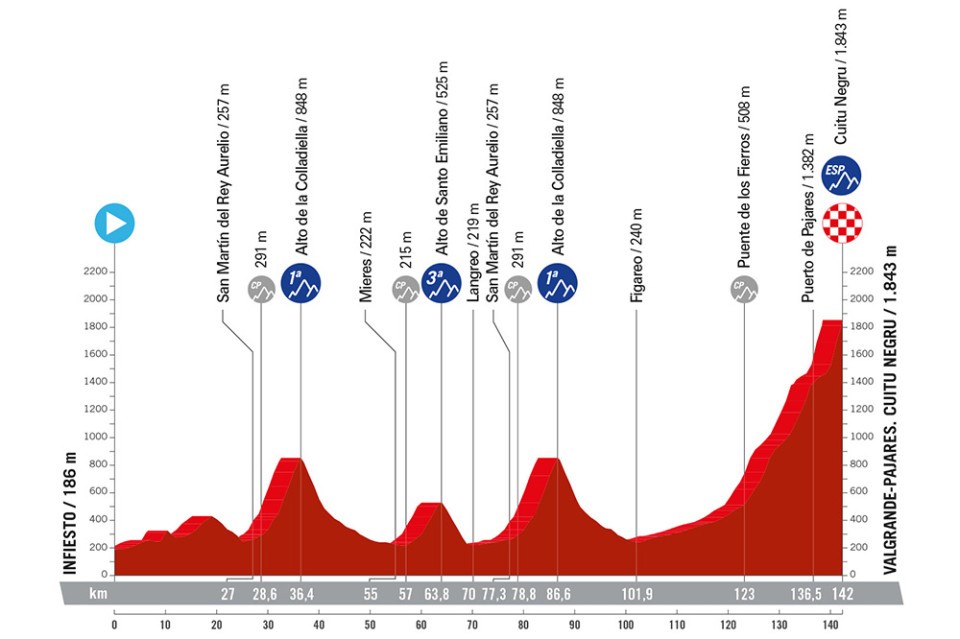
Stage through Asturias "very difficult, unpredictable terrain even before last climb" warns EF Education-Easy Post's Juanma Garate
The 2024 Vuelta a España celebrates its return to its northern heartland of Asturias on Sunday with one of the hardest stages of the entire race, and - together with Lagos de Covadonga and Ancares - what is undoubtedly one of the three most difficult summit finishes this year, at Cuitu Negru.
Looking at a race profile of stage 14, the sheer size of the final ascent of Cuitu Negru, towering over the rest of the mountainous challenges of the day through the rain-soaked, verdant region of Asturias, inevitably draws the eye. Officially a whopping 18.9 kilometres long, the hard reality is the road starts to rise gently but steadily another 21 kilometres earlier, to total just under a third of the entire 142.9-kilometre stage.
Worst of all for the Vuelta peloton is that the higher it goes, the steeper the Cuitu Negru gets. After a relatively gentle series of lower slopes, the final two kilometres of the Puerto de Pajares segment, for decades the point where Vuelta stages on the Asturian mountain pass would end, never drops below 9%, which is bad enough. In the 1980s the Vuelta first moved its finish of the same climb a little higher to Brañillin ski station. Then, once the road to the Cuitu Negru ski slopes above Brañillin had been tarmacked in 2012, a further 2.5 kilometres were added to the ascent - and this final part of the current climb features multiple gravity-defying ramps of over 25%.
To grasp how difficult such a climb is, the TV images of 2012 stage winner Dario Cataldo weaving from side to side on the upper slopes of the Cuitu, desperately seeking even the slightest drop in the unforgiving gradient, speak for themselves. But the words of Robert Gesink after the 2012 stage, present in this year's race as well are equally graphic.
"I have never seen anything as hard than the Cuitu Negru," Gesink said on the team's homepage. "This last climb is hell, in fact. The Angliru is also very steep, but it's more regular. The last three kilometres were horrible. It was steeper than the Angliru. I almost fell off the back of my bike."
"It's an incredibly hard finish," Mikel Landa told Spanish television, "I remember when we went up it in 2012, the last part of the ascent caught everybody out because we needed special gearing to handle the steepness and most of us didn't have it."
However, as EF Education-EasyPost director Juanma Garate tells Cyclingnews, it would be a major error to reduce the stage to just the final climb. Before the Cuitu Negru, the peloton tackles the short, but very sharp, category 1 Alto de la Colladiella twice, as well as the category 3 Alto de Santo Emiliano. Cram that all into just 144 kilometres and it means that almost from the gun, there's barely a metre of flat all day.
"Cuitu Negru is very similar to Ancares in its final segment, three really steep kilometres at Cuitu compared to Ancares' four kilometres. But the big difference is that the riders will reach that last part of the ascent with a lot of climbing already in their legs, so it'll feel very different;" Garate says.
"It's not just the Pajares segment of the last climb, either. The roads are very difficult, twisting and narrow and up and down all day. "
"That harder, more technical terrain throughout has two big effects: it makes it a full-scale mountain stage, not like on Friday, and it makes it much easier for ambushes. As a result, a lot of teams will adopt a very different strategy for the day's racing."
Regarding EF leader Richard Carapaz, currently lying fourth overall, Garate says they are not ruling out going for the victory.
"I wouldn't sign for the podium right now and neither would he," Garate told Cyclingnews. "Richard's not that kind of rider."
"He did well on Ancares because it started out really fast and the riders who tried to stick with [Primoz] Roglič paid a high price. But Richard was pleased with the result and so was I."
"That said, he's still a way off being able to go for the lead right now, and when you look at how well Roglič performed on Ancares, it's impressive."
After losing both Rigoberto Urán and Rui Costa in quick succession to crashes and injuries in the first week, Garate says that the depletion of numbers means EF have been obliged to race more conservatively than they might like.
"We're doing a really good job, given two riders dropped out with injuries so early in the race - that's like getting two red cards in a football game in the tenth minute," Garate said. "It's meant five riders have to do the work of seven, and that really drains them a lot."
"So we're trying to use them as little as possible, while always protecting Richard in the finales. But the atmosphere amongst the team is still really good, one of them said to me the other day it was probably the most relaxed vibe of all three of the Grand Tours. Certainly the most enjoyable."
"There's still a long way to go, too. It seems like it's going to rain quite a lot too from hereon, and we all know how sketchy it can get in Asturias in the wet. So the Vuelta is not decided by a long shot - not yet, anyway. And we'll try and play our cards in it, too."
Get unlimited access to all of our coverage of the 2024 Vuelta a España - including breaking news and analysis reported by our journalists on the ground from every stage as it happens and more. Find out more.







